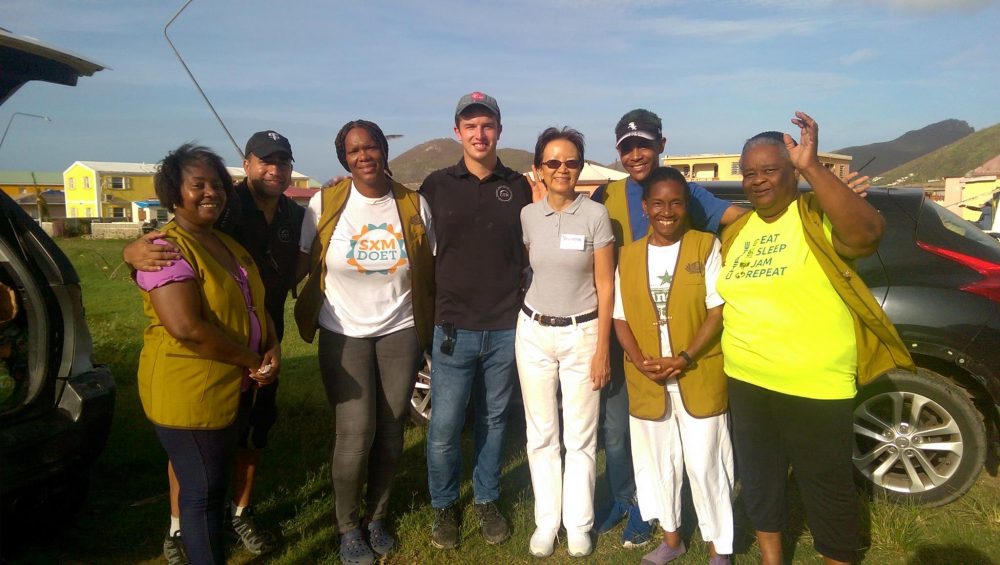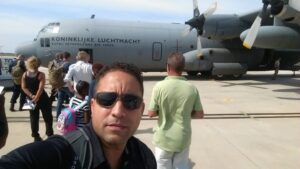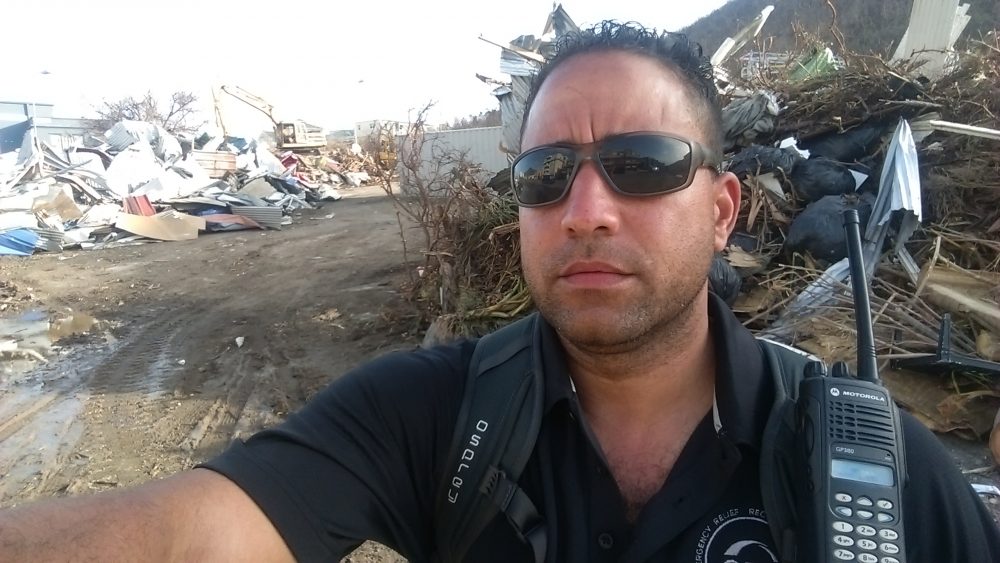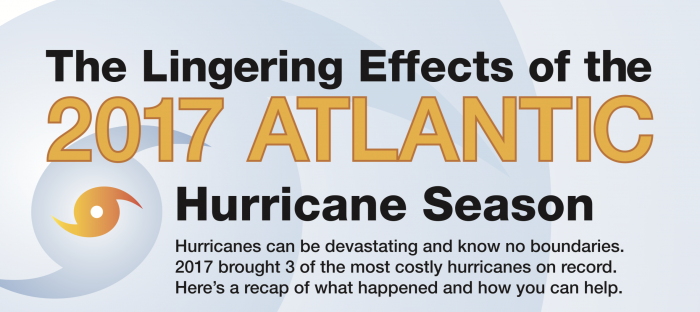My Relationship with Hurricane Irma
Many professionals in the humanitarian response and programs space can highlight a disaster that significantly impacted their lives or careers. While I can think of a few such disasters, there is only one that followed me for multiple years in my career. For nearly four years, I have been in a relationship with Hurricane Irma. […]

Many professionals in the humanitarian response and programs space can highlight a disaster that significantly impacted their lives or careers. While I can think of a few such disasters, there is only one that followed me for multiple years in my career.
For nearly four years, I have been in a relationship with Hurricane Irma. Personally, it taught me how one’s profession and passion could dictate one’s journey in life. It also highlighted the inequalities in disaster response and recovery assistance and programs. I observed the disproportionate impacts and subsequent recovery needs Irma had on many communities across the Caribbean and Florida. I saw firsthand the vital role of localization in disaster recovery and ways that philanthropy can support these efforts.
A devastating hurricane
I recall when I was first introduced to Hurricane Irma in August 2017. I was sitting in my home office on a small island in Puget Sound in Washington State. It was more than 24 hours since Hurricane Irma tore across the small but mostly flat, pristine Caribbean island of Barbuda. The images on cable news were the first the world would see of Irma interacting with land, people and communities across an unprecedented number of the Caribbean islands before cutting Florida in half as it marched north from the Florida Keys through the heart of Central Florida and onwards.

Two weeks later, I find myself in a Royal Dutch Military cargo plane from Curacao to Sint Maarten, heading into the post-disaster situation Irma left behind. My mission as team leader was to assess and identify early recovery programming opportunities with a focus on the biggest challenge Sint Maarten and just about every other small Caribbean island was facing: What do you do with all of the debris from a Category 5 hurricane when you live on a small, environmentally sensitive island? You can’t bury it. You can’t afford to ship it all away. And you don’t have the mass waste management capacity to sustain robust recycling programs.
Two weeks later, I arrived in Puerto Rico and saw the aftermath of Hurricanes Irma and Maria. I witnessed how a series of disasters – natural and human-made – had exposed the island’s vulnerability as well as its strengths. I would coordinate and manage emergency food and water distributions across all seventy-eight municipalities across Puerto Rico’s three main islands for nearly two months. It was an unbelievable logistical task for an island-nation that lost most of its food supply chain and energy infrastructure.
I do not pretend to believe that we saved any lives, but we provided many with hope and hugs to communities across the island that thought they were forgotten. It was a reminder that what we give to families and communities after disasters is sometimes not as important as how we give it to them: with compassion and dignity.
Days before Thanksgiving 2017, I found myself leaving my family for the third time in as many months. This time I was headed to Antigua and Barbuda for a long-term mission as the Head of Operations for Hurricane Irma Recovery. On Thanksgiving Day, I would find myself on that tiny, flat island I first learned about less than three months earlier, seeing the destruction Irma left behind.
Hurricane Irma had taken away Barbudans’ livelihoods, homes and access to critical services such as education, health care and financial services. It seemed as if Irma had attacked Barbuda, and the island was now slowly suffocating. For the first time in its 300-year history, the island was declared uninhabitable. An entire community, entire nation, a sister island nation to Antigua was declared unsafe.

How do you begin recovery?
In Barbuda, like many Caribbean islands, it started with “re-populating” the island. It was getting people back into their communities and homes and addressing barriers to and needs for long-term recovery. I advocated for Irma survivors by working with them to work with the government, private sector and philanthropy to fill gaps and provide resources.
I learned so much about Barbuda, its sole community of Codrington, its people, culture and history. It taught me more about total and complete community recovery during that year than I had in the previous 10 years of humanitarian programming. I was embedded in the community and used a localization approach to engage and empower Barbudans to identify their needs, identify resources and plan long-term recovery for their island nation.
Supporting post-Irma recovery in Florida
After a year in the Caribbean visiting some of Irma’s destinations and learning a lot about how the entire 2017 Atlantic hurricane season changed the region forever, I found myself unable to break-up with Irma. I was back in the U.S. and had taken on a fantastic disaster philanthropy portfolio that included the CDP Hurricane Irma Recovery Fund and grants across Florida. Little did I know that Irma wasn’t finished with me and our relationship was only in its infancy.
For three years as Center for Disaster Philanthropy’s (CDP) Director of Disaster Recovery Funds, I have engaged philanthropy and ensured that Irma’s final chapter in Florida would not be forgotten. CDP mobilized funders to promote collaboration and garner resources. We leveraged our funding to bring other funders to the table to support housing recovery, including repairs and rebuilding.
We worked with local nonprofits and community groups to support post-Irma recovery across the state, including partners like Centro Campesino, the Monroe Long Term Recovery Group and the Redlands Christian Migrant Association’s Immokalee Unmet Needs Coalition, to name a few. Many of the grants and programs focused on housing, the most common recovery need that communities identified.
With our grants to Centro Campesino, we partnered with an organization with decades of trust and deep relationships within the community. It is an organization that looks like the community it serves. Centro Campesino provided CDP and philanthropy with an opportunity for highly targeted support to the large and largely forgotten migrant and farmworker communities of southern Florida disproportionately affected by Irma, with many losing their homes and livelihoods at the same time.
Lessons for disaster philanthropy
There is much that I have learned from my affair with Hurricane Irma that has defined my approach to disaster response and recovery programming. I share these lessons below in the hopes that they provide insights for other funders even as I transition from my role at CDP in early April.
- Invest in the right implementation partner. Part of smart disaster response, recovery and philanthropy involves finding and supporting partners with the sets of skills and resources needed for a specific disaster. It is also vital to allocate early investments in a timely manner and in response to immediate critical needs to promote community-wide recovery such as debris clean-up and removal, re-establishing education and basic health services.
- Allocate more disaster dollars (for mitigation, risk reduction, preparedness, response and recovery) directly to America’s communities of color and promote more equity in disaster programs. Especially here in the United States, there is a disproportionately higher percentage of Black, Indigenous and other communities of color living in zip codes with a lower baseline than their white compatriots. Grantmakers need to target these communities and the nonprofits that serve them directly. They need to stop relying on organizations that only indirectly support these communities under the traditional and outdated approach of prioritizing a large geographic area without intentionally reaching communities affected disproportionately by a disaster.
As I depart from CDP, I urge philanthropy and humanitarian organizations to continue assessing disasters with the appropriate lenses and prioritize equitable programs. My four-year relationship with Hurricane Irma opened my eyes to new positive aspects of disaster response and recovery while validating many negative ones.
It also reinforced the importance of timely, coordinated and equitable philanthropic engagement with local nonprofits and groups that are genuinely part of the community. While there will never be another Hurricane Irma, there will be hurricanes like her and even stronger.
More like this

Seven Things You Need to Know About the 2017 Atlantic Hurricane Season

